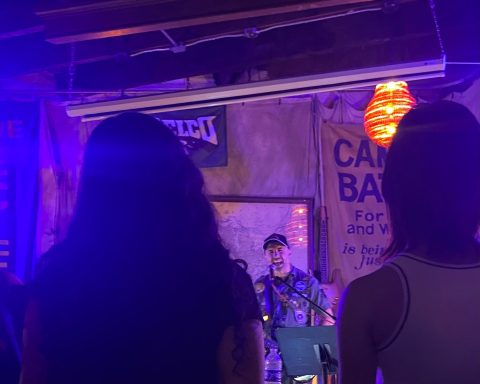Editor’s note: This article was initially published in The Daily Gazette, Swarthmore’s online, daily newspaper founded in Fall 1996. As of Fall 2018, the DG has merged with The Phoenix. See the about page to read more about the DG.
David Levithan’s novel Two Boys Kissing (2013) is most definitely a staple of LGBTQ teen fiction, presenting a story that weaves the various experiences of queer, teen boys around one eventful kiss (but more than two of them kiss, I promise). The novel moves through the plot with a direct and honest narrative form of prose typical of teen fiction. However, in the more intimate moments, Levithan slows down the pace and allows the omniscient narrator to poetically address the readers. Two Boys Kissing distinguishes itself through its poetic language, but even more so by the fact the the narrator isn’t the one, all-knowing entity that fiction usually establishes. Rather, the narrator of the novel is a “we,” the generations of queer men that have lived through (and in some cases died because of) the same experiences that the boys of Two Boys Kisses endure.
York University Associate Professor of English Lily Cho writes about queer diasporic subjects in “Future perfect loss: Richard Fung’s Sea in the Blood” that:
“…queer diasporic subjects might find collectivities and solidarities defined through a ‘collective memory of historical loss and continued suffering’, but not bound to that history in a state of perpetual melancholia.”
Cho argues that a collective sense of queer identity is formed in the recognition of the suffering and oppression that queer subjects have felt throughout history. Furthermore, she argues that proleptic loss, or loss that has yet not happened but is “on the horizon,” can be the basis for political activity. It is the recognition that as queer subjects, given the history of violence enacted upon queer bodies, the violence will continue but the present moment allows for action that can alter such a future.
The narrator(s) of Two Boys Kissing hold this same understanding, establishing the connection between the past and the future, telling readers that “In the meantime, we are vigilant. Deaths like ours teach you to be vigilant” (67). Queer subjects are vigilant only because historical violence and oppression have demonstrated that this vigilance is necessary to survive. Violence is portrayed to be an inevitable aspect of queer existence, exemplified by the physical violence and humiliation that the characters of Two Boys Kissing face. The violence is different. The characters’ generation isn’t facing the AIDS crisis that the narrator lived through. As time passes, the forms of violence and oppression change, but “change” does not mean “absent.” Violence is constant to queer existence.
But as Cho argues, recognition of this historical and continual violence on queer bodies can be a basis for a collective identity of queerness and political energy that can change the future. Levithan is aware of this too. On the first page of the novel, the narrator establishes this potential when they say “Trust us: There is a nearly perfect balance between the past and the future. As we become the distant past, you become a future few of us would have imagined.” As queer teens of the present generation, the characters are creating a future of hope and change that few would have imagined so many years ago. Despite the individual struggles that each character faces, their actions are a form of resistance that shape the future into what it is. Each kiss that occurs, each defiant statement of their existence and power, is creating a future where violence will not be a constant norm to the lives of queer teenagers.
Two Boys Kissing is a strong work of queer teen fiction, particularly because it’s grounded in the reality of lived queer experiences, both past and present. Based on the real 2010 Guinness World Record of the longest kiss held (this time, between two boys) and the suicide of another gay college student four days later only a few miles away from the location of the kiss, the novel succeeds in depicting both the magic and suffering of queer teen boys’ lives. While it is a reminder of the historical violence enacted upon queer bodies, it also works to recognize that queer existence is not solely defined by this violence; there exists so much potential for change and love outside of this violence too.
Image courtesy of Brandon Torres’18.












